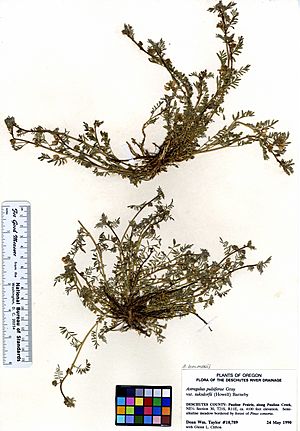Lemmon's milkvetch facts for kids
Quick facts for kids Astragalus lemmoniiLemmon's milkvetch |
|
|---|---|
 |
|
| Conservation status | |
| Scientific classification |
The Astragalus lemmonii, also known as Lemmon's milkvetch, is a rare plant found in eastern California. It belongs to the bean family, called Fabaceae (or Leguminosae). This plant is part of a large group of plants known as milkvetches or locoweeds, which are all in the Astragalus genus. Some of its close plant relatives include Astragalus peckii and Astragalus lentiformis.
Contents
What Does Lemmon's Milkvetch Look Like?
This plant is a perennial plant, meaning it lives for more than two years. It has a thick, fleshy taproot that can also be woody. The plant's leaves are green, but they have tiny, stiff hairs (called strigose hairs) that lie flat against the surface.
Its stems are thin and grow out from the top of the root. They usually lie flat on the ground or grow close to it. These stems are soft and green near the bottom and can be 10 to 50 centimeters long. Small leaf-like parts called stipules (2–5 mm long) are found at the base of the leaves.
The leaves are 1 to 4.5 centimeters long and have 7 to 15 smaller leaflets. These leaflets are narrow and can be shaped like a spear or an oval. Their tips are usually pointed. The very last leaflet on each leaf is often wider than the thin stalk it's attached to.
Flowers and Pods
The flowers of Lemmon's milkvetch grow in groups called inflorescences. These groups often appear in pairs where the leaves meet the stem. One group of flowers usually blooms earlier than the other.
The flower stalks, called peduncles, are thin and usually curve upwards. They are about 1 to 2 centimeters long, which is shorter than the leaves. Each stalk has several flowers (from 2 to 13) clustered at its end. These flowers point upwards in a tight cluster.
The outer parts of the flower, called the calyx, are covered in fine white or black hairs. The calyx forms a short, bell-shaped tube about 2 millimeters high. The petals, called the corolla, are a creamy white color, sometimes with hints of dull purple or lilac veins. The largest petal, called the banner, is about 4.75 to 6 millimeters long and curves backward. The other petals, called wings and keel, are almost as long.
After the flowers bloom, small pods develop. These pods are attached directly to the plant without a stalk. They are covered in fine hairs and often spread out or lie on the ground. The pods are oval-shaped, either straight or slightly curved, and have a blunt base and a pointed tip. They are thick and usually have two compartments (bilocular). When you look at a cross-section, they look heart-shaped or triangular. The pods are thin and papery, changing from green to brownish. They are 4 to 7 millimeters long and 1.5 to 2.5 millimeters wide. Each pod contains a few seeds (4 to 8).
Where Lemmon's Milkvetch Lives
This plant is not very common and is found in scattered locations. Its range stretches from the eastern foothills of the Cascades in southwestern Oregon down to the Sierra Nevada mountains in southern California. It also extends a little into western Nevada.
Lemmon's milkvetch prefers moist places within Great Basin sagebrush areas. You can often find it in wet, grassy, or marshy spots next to streams and lake shores. It also grows in meadows, wet areas, and marshes that are moist in spring but dry out in summer. Sometimes, it can be found in non-wetland areas too. This plant grows in rare and scattered groups at elevations from about 4,200 to 7,225 feet above sea level.
Protecting Lemmon's Milkvetch
Lemmon's milkvetch is considered a sensitive species, meaning it needs special attention to protect it.
- The United States Forest Service in the Pacific Southwest Region lists it as a Sensitive Species.
- The California Native Plant Society has it on List 1B.2. This means it's rare, threatened, or endangered in California and other places, and it's considered fairly endangered in California.
- NatureServe gives it a California State Rank of S2.2 and a Global Rank of G3. These ranks show that the plant is vulnerable and at moderate risk of extinction.
Some of the main dangers to this plant include land being changed for building and the construction of pipelines.
How to Identify Lemmon's Milkvetch
The best time to identify Lemmon's milkvetch is when it is blooming. This usually happens from late May to early August.


